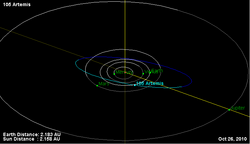Astronomy:105 Artemis
 Orbital diagram | |
| Discovery | |
|---|---|
| Discovered by | James Craig Watson |
| Discovery date | 16 September 1868 |
| Designations | |
| (105) Artemis | |
| Pronunciation | /ˈɑːrtɪmɪs/[1] |
| Named after | Artemis |
| A868 SA | |
| Minor planet category | Main belt |
| Adjectives | Artemidean / Artemidian /ɑːrtɪˈmɪdiən/[2][3] Artemisian /ɑːrtɪˈmɪziən/[4] |
| Orbital characteristics[5] | |
| Epoch 31 July 2016 (JD 2457600.5) | |
| Uncertainty parameter 0 | |
| Observation arc | 100.79 yr (36812 d) |
| |{{{apsis}}}|helion}} | 2.7952 astronomical unit|AU (418.16 Gm) |
| |{{{apsis}}}|helion}} | 1.95119 AU (291.894 Gm) |
| 2.37319 AU (355.024 Gm) | |
| Eccentricity | 0.17782 |
| Orbital period | 3.66 yr (1335.4 d) |
| Average Orbital speed | 19.18 km/s |
| Mean anomaly | 256.90° |
| Mean motion | 0° 16m 10.524s / day |
| Inclination | 21.444° |
| Longitude of ascending node | 188.264° |
| 57.077° | |
| Earth MOID | 1.00955 AU (151.027 Gm) |
| Jupiter MOID | 2.31243 AU (345.935 Gm) |
| TJupiter | 3.430 |
| Physical characteristics | |
| Dimensions | 119.08±2.8 km[6] |
| Mass | (1.54 ± 0.54) × 1018 kg[7] |
| Mean density | 1.73 ± 0.67 g/cm3[7] |
Equatorial surface gravity | 0.0333 m/s² |
Equatorial escape velocity | 0.0630 km/s |
| Rotation period | 37.15506 h (1.548128 d)[5] 37.15 h[8] |
| Geometric albedo | 0.0465±0.002 |
| Physics | ~180 K |
| C (Tholen) Ch (Bus)[9] | |
| Absolute magnitude (H) | 8.57 |
Artemis (minor planet designation: 105 Artemis) is a main-belt asteroid that was discovered by J. C. Watson on September 16, 1868, at Ann Arbor, Michigan. It was named after Artemis, the goddess of the hunt, Moon, and crossways in Greek Mythology.[10]
It is a C-type asteroid,[9] meaning that it is very dark and composed of carbonaceous material. Although it shares a similar orbit to the Phocaea family of S-type asteroids, its classification means 105 Artemis is not a member.[11] The spectra of the asteroid displays evidence of aqueous alteration.[12]
In 1988, this object was detected with radar from the Arecibo Observatory at a distance of 1.07 AU. The measured radar cross-section was 1,800 km2.[13] Photometric measurement of this asteroid made in 2010 at Organ Mesa Observatory in Las Cruces, New Mexico, produced an irregular light curve with a period of 37.150 ± 0.001 hours. During each rotation, the brightness varies by 0.16 ± 0.01 in magnitude.[8]
Based upon radar data, the estimated near surface solid density of the asteroid is 3.0+0.9−0.8 g cm−3.[14] Refined observations by the Arecibo Observatory, reported in 2006, showed a complex surface with varying albedo. Analysis of the spectra of 105 Artemis shows the presence of hydrated minerals at some rotation angles, but not at others.[15]
An occultation of the star HD 197999 was observed in 1982, which gave an estimated chord length of 110 km.[16] Between 1981 and 2021, 105 Artemis has been observed to occult 23 stars.
References
- ↑ Noah Webster (1884) A Practical Dictionary of the English Language
- ↑ Sophocles (1902 trans.)
- ↑ Dowden (1989) Death and the maiden: girls' initiation rites in Greek mythology
- ↑ Fischer-Hansen & Poulsen (2009) From Artemis to Diana
- ↑ 5.0 5.1 Yeomans, Donald K., "105 Artemis", JPL Small-Body Database Browser (NASA Jet Propulsion Laboratory), https://ssd.jpl.nasa.gov/sbdb.cgi?sstr=105, retrieved 12 May 2016.
- ↑ Tedesco, E. F.; Noah, P. V.; Noah, M.; Price, S. D. (October 2004). "IRAS Minor Planet Survey V6.0". NASA Planetary Data System 12: IRAS-A-FPA-3-RDR-IMPS-V6.0. Bibcode: 2004PDSS...12.....T. https://sbnarchive.psi.edu/pds3/iras/IRAS_A_FPA_3_RDR_IMPS_V6_0/data/diamalb.tab. Retrieved 22 October 2019.
- ↑ 7.0 7.1 Carry, B. (December 2012), "Density of asteroids", Planetary and Space Science 73: pp. 98–118, doi:10.1016/j.pss.2012.03.009, Bibcode: 2012P&SS...73...98C. See Table 1.
- ↑ 8.0 8.1 Pilcher, Frederick (October 2010), "New Lightcurves of 40 Harmonia and 105 Artemis", The Minor Planet Bulletin 37 (4): p. 167, Bibcode: 2010MPBu...37..167P.
- ↑ 9.0 9.1 DeMeo, Francesca E. et al. (2011), "An extension of the Bus asteroid taxonomy into the near-infrared", Icarus 202 (1): 160–180, doi:10.1016/j.icarus.2009.02.005, Bibcode: 2009Icar..202..160D, archived from the original on 2014-03-17, https://web.archive.org/web/20140317200310/https://www.tara.tcd.ie/bitstream/2262/43276/1/PEER_stage2_10.1016/j.icarus.2009.02.005.pdf, retrieved 2013-03-22. See appendix A.
- ↑ Schmade, Lutz (2003), Dictionary of Minor Planet Names, 1 (5th ed.), Springer, p. 25, ISBN 3540002383, https://books.google.com/books?id=KWrB1jPCa8AC&pg=PA25.
- ↑ Carruba, Valerio et al. (September 2009), "An Analysis of the Region of the Phocaea Dynamical Family", American Astronomical Society, DPS meeting #41, #27.04, Bibcode: 2009DPS....41.2704C, http://www.feg.unesp.br/~vcarruba/phocaea.pdf, retrieved 2013-03-18.
- ↑ Fornasier, S. et al. (February 1999), "Spectroscopic comparison of aqueous altered asteroids with CM2 carbonaceous chondrite meteorites", Astronomy and Astrophysics Supplement 135: 65–73, doi:10.1051/aas:1999161, Bibcode: 1999A&AS..135...65F.
- ↑ Ostro, S. J. et al. (October 1991), "Asteroid radar astrometry", Astronomical Journal 102: pp. 1490–1502, doi:10.1086/115975, Bibcode: 1991AJ....102.1490O.
- ↑ Magri, C. et al. (December 2001), "Radar constraints on asteroid regolith compositions using 433 Eros as ground truth", Meteoritics & Planetary Science 36 (12): pp. 1697–1709, doi:10.1111/j.1945-5100.2001.tb01857.x, Bibcode: 2001M&PS...36.1697M.
- ↑ Hanson, Heather M. et al. (December 2006), "Correlating Arecibo Radar and IRTF Near-Infrared Spectral Observations of 105 Artemis", Bulletin of the American Astronomical Society 38: p. 933, Bibcode: 2006AAS...209.2504H.
- ↑ Byrne, P. B. et al. (September 1982), "Observations of the occultation of HD 197999 by the minor planet 105 Artemis", Monthly Notices of the Royal Astronomical Society 200: p. 65P–68P, doi:10.1093/mnras/200.1.65p, Bibcode: 1982MNRAS.200P..65B.
External links
- 105 Artemis at AstDyS-2, Asteroids—Dynamic Site
- 105 Artemis at the JPL Small-Body Database
 |

